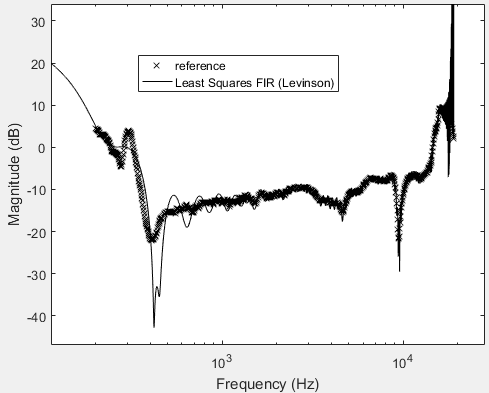I'm using Matt. L.'s lslevin.m function to design long ($N\approx 400$) filters to an arbitrary phase and magnitude specification. The specification is the result of a numeric optimization and does cover frequencies between 200Hz and 19kHz. I found that the designed filters show poor approximation of my desired frequency response $H_1[k]$:
Apparently my desired response it hard to meet. Making the filters longer only amplifies the ripple. So I added a linear phase term $H_2[k] = H_1[k]e^{-j\frac{N-1}{2}\omega[k]}$ in the hope to make the desired response a little more realistic to meet. I am not sure why this is requried or why it makes things better, but it appears to be doing something. (Adding a (predictable) phase term to my filters is okay in my scenario as long as two filters designed with the same length have the same phase term added) Here's the result:
However, outside the range of specified frequencies I see huge spikes in the magnitude response (which is to be expected, because I don't control those regions at all):
So I extended my specification by padding $H_2[k]$ with zeros on both sides. I give a weight of 2 to all points inside my specification and a weight of 1 to all the padded zeros - my hope is that I will get a band-pass behaviour with my desired phase and magnitude response in the passband and some sort of suppression outside the passband. I don#t really care about those regions but the huge magnitude from the previous example makes the impulse response have very large coefficients with varying sign which is impossible to implement. With the padding added, things start to look better.
As you can (maybe) see, there is some ripple above 19kHz but in this case it stays low. If I increase the filter length $N$ to 600 or more - hoping to increase the accuracy of LS approximation in the passband - those ripples become extremely large, with the maxima reaching up to +50dB. Which makes this filter impossible to implement.
So as you can tell, I'm not entirely sure what I'm doing. How can I find a gradient of the linear phase term that yields the best approximation? How can I prevent huge magnitudes outside my important region of 200Hz-19kHz?




